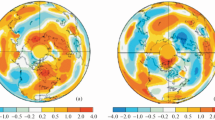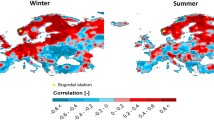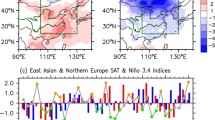Abstract
Possible mechanisms for the formation of significant weather and climate anomalies in Russia in recent years and their relation to global climate change and natural quasicyclic processes are discussed. Extreme Russian heat wave in 2010, the Amur River flood in 2013, and extreme cold winters are analyzed. All these events were associated with the formation of long-lived blocking anticyclones whose frequency increase can be expected under conditions of global warming. To link such events with the global warming, the effects related to regional and global climatically significant natuial quasicyclic processes should be taken into account. They include the Atlantic Multidecadal Oscillation, Pacific Decadal Oscillation, and El Niño—Southern Oscillation.
Similar content being viewed by others
References
G. M. Agayan, “Quasistationary Autumn Patterns of the Northern Hemisphere Atmosphere in the Period of FGGE,” Izv. Akad. Nauk, Fiz. Atmos. Okeana, No. 11, 25 (1989) [in Russian].
Analysis of Extreme Weather Conditions on the Territory of Russia in Summer 2010 (Triada ltd, Moscow, 2011) [in Russian].
K. Arpe, L. Bengtsson, G. S. Golitsyn, et al., “Analysis and Modeling of the Hydrological Regime Variations in the Caspian Sea Basin,” Dokl. Akad. Nauk, No. 2, 366 (1999) [Dokl. Phys., 366 (1999)].
A. V. Baidin and V. P. Meleshko, “Response of the Atmosphere at High and Middle Latitudes to the Reduction of Sea Ice Area and the Rise of Sea Surface Temperature,” Meteorol. Gidrol., No. 6 (2014) [Russ. Meteorol. Hydrol., No. 6, 39 (2014)].
P. N. Vargin, A. N. Luk'yanov, and A. V. Gan'shin, “Investigation of Dynamic Processes in the Period of Formation and Development ofthe Blocking Anticyclone over European Russia in Summer 2010,” Izv. Akad. Nauk, Fiz. Atmos. Okeana, No. 5, 48 (2012) [Izv., Atmos. Oceanic Phys., No. 5, 48 (2012)].
E. M. Volodin, “On the Nature of Some Superextreme Anomalies of Summer Temperature,” in Analysis of Extreme Weather Conditions on the Territory of Russia in Summer 2010 (Triada ltd, Moscow, 2011)[in Russian].
Roshydromet Second Assessment Report on Climate Change and Its Consequences on the Territory of the Russian Federation (Roshydromet, Moscow, 2014) [in Russian].
A. S. Ginzburg, “Regional Air Temperature Maxima and the Possibility of Their Simple Energy-balance Estimates,” Izv. Akad. Nauk, Fiz. Atmos. Okeana, No. 6, 47 (2011) [Izv., Atmos. Oceanic Phys., No. 6, 47 (2011)].
G. S. Golitsyn, I. I. Mokhov, M. G. Akperov, and M. Yu. Bardin, “Distribution Functions of Probabilities of Cyclones and Anticyclones in 1952–2000: An Instrument for the Determination of Global Climate Variations,” Dokl. Akad. Nauk, No. 2, 413 (2007) [Dokl. Phys., No. 2, 413 (2007)].
G. S. Golitsyn, I. I. Mokhov, M. G. Akperov, et al., “Assessment of Hydrological Risks and Functions of Atmospheric Vortex Intensity Distribution Based on Reanalysis Data and Climate Models,” Problemy Analiza Riska, No. 1, 4 (2007) [in Russian].
G. S. Golitsyn, I. I. Mokhov, M. G. Akperov, et al., “Assessment of Hydrological Risks and Functions of Atmospheric Vortex Intensity Distribution Based on Reanalysis Data and Model Computations,” in Prediction and Adaptation of Society to Extreme Climate Changes (Triada ltd, Moscow, 2007) [in Russian].
G. S. Golitsyn, I. I. Mokhov, and V. Ch. Khon, “Diagnosis and Modeling of Changes in Hydrological Conditions in the Caspian Sea Basin in the 20th and 21st Centuries,” in Environmental Problems of the Caspian Sea (RAN/NAN SShA, Moscow, Kirov, 2000) [in Russian].
G. V. Gruza and E. Ya. Ran'kova, “Estimation of Probable Contribution of Global Warming to the Genesis of Abnormally Hot Summers in the European Part of Russia,” Izv. Akad. Nauk, Fiz. Atmos. Okeana, No. 6, 47 (2011) [Izv., Atmos. Oceanic Phys., No. 6, 47 (2011)].
G. V. Gruza, E. Ya. Ran'kova, L. K. Kleshchenko, and L. N. Aristova, “A Relationship between Climate Anomalies over Russia and El Niño-Southern Oscillation Events,” Meteorol. Gidrol., No. 5 (1999) [Russ. Meteorol. Hydrol., No. 5 (1999)].
V. I. Danilov-Danil'yan, A. N. Gel'fan, Yu. G. Motovilov, and A. S. Kalugin, “Disastrous Flood of 2013 in the Amur Basin: Genesis, Recurrence Assessment, Simulation Results,” Vodnye Resursy, No. 2, 41 (2014) [Water Resources, No. 2, 41 (2014)].
V. I. Danilov-Danil'yan, A. N. Gel'fan, Yu. G. Motovilov, and A. S. Kalugin, “Modeling of 2013 Disastrous Flood Formation in the Amur Basin,” in ExtremeFloods in the Amur RiverBasin: Causes, Forecasts, andRecommendations (Roshydromet, Moscow, 2014) [in Russian].
I. V. Zheleznova and D. Yu. Gushchina, “The Response of Global Atmospheric Circulation to Two Types of El Niño,” Meteorol. Gidrol., No. 3 (2015) [Russ. Meteorol. Hydrol., No. 3, 40 (2015)].
V. D. Kaznacheeva and I. V. Trosnikov, “Estimation of Dependence of Seasonal Predictability of Meteorological Quantities in Different Regions of the Northern Hemisphere on the El Niño-Southern Oscillation Phenomenon,” Meteorol. Gidrol., No. 2 (2008) [Russ. Meteorol. Hydrol., No. 2, 33 (2008)].
V. P. Meleshko, G. S. Golitsyn, E. M. Volodin, et al., “Calculation of Water Balance Components over the Caspian Sea Watershed with a Set of Atmospheric General Circulation Models,” Izv. Akad. Nauk, Fiz. Atmos. Okeana, No. 4, 34 (1998) [Izv., Atmos. Oceanic Phys., No. 4, 34 (1998)].
A. V. Meshcherskaya, V. M. Mirvis, and M. P. Golod, “Drought of 2010 against a Background of Long-term Variations of Aridtty in Basic Grain-sowing Regions in the European Part of Russia,” Trudy GGO, No. 563 (2011) [in Russian].
I. I. Mokhov, “Hydrological Anomalies and Tendencies of Change in the Basin of the Amur River under Global Warming,” Dokl. Akad. Nauk, No. 5, 455 (2014) [Dokl. Phys., No. 2, 455 (2014)].
I. I. Mokhov, “Action as an Integral Characteristic of Climatic Structures: Estimates for Atmospheric Blockings,” Dokl. Akad. Nauk, No. 3, 409 (2006) [Dokl. Phys., No. 6, 409 (2006)].
I. I. Mokhov, “Specific Features of the 2010 Summer Heat Formation in the European Territory of Russia in the Context of General Climate Changes and Climate Anomalies,” Izv. Akad. Nauk, Fiz. Atmos. Okeana, No. 6, 47 (2011) [Izv., Atmos. Oceanic Phys., No. 6, 47 (2011)].
I. I. Mokhov, “Contemporary Climate Changes in the Arctic,” Vestnik Akad. Nauk, No. 5-6, 85 (2015) [Herald of the Russ. Acad. Sci., No. 3, 85 (2015)].
I. I. Mokhov, M. G. Akperov, M. A. Prokofeva, et al., “Blockings in the Northern Hemisphere and Euro-Atlantic Region: Estimates of Changes from Reanalysis Data and Model Simutations,” Dokl. Akad. Nauk, No. 5, 449 (2013) [Dokl. Phys., No. 2, 449 (2013)].
I. I. Mokhov, J.-L. Dufresne, H. Le Treut, et al., “Changes in Drought and Bioproductivity Regimes in Land Ecosystems in Regions of Northern Eurasia Based on Calculations Using a Global Climatic Model with Carbon Cycle,” Dokl. Akad. Nauk, No. 6, 405 (2005) [Dokl. Phys., No. 9, 405 (2005)].
I. I. Mokhov, A. V. Eliseev, and D. V. Khvorostyanov, “Evolution of the Characteristics of Interannual Climate Variability Associated with the El Niño and La Niña Phenomena,” Izv. Akad. Nauk, Fiz. Atmos. Okeana, No. 6, 36 (2000) [Izv., Atmos. Oceanic Phys., No. 6, 36 (2000)].
I. I. Mokhov and V. K. Petukhov, “Blockings and the Tendencies toward Their Variation,” Dokl. Akad. Nauk, No. 5, 357 (1997) [Dokl. Phys., No. 9, 357 (1997)].
I. I. Mokhov, V. K. Petukhov, and V. A. Semenov, “Multiple Intraseasonal Temperature Regimes and Their Evolution in the IAP RAS Climate Model,” Izv. Akad. Nauk, Fiz. Atmos. Okeana, No. 2, 34 (1998) [Izv., Atmos. Oceanic Phys., No. 2, 34 (1998)].
I. I. Mokhov, V. A. Semenov, and V. Ch. Khon, “Estimates of Possible Regional Hydrologic Regime Changes in the 21st Century Based on Global Climate Models,” Izv. Akad. Nauk, Fiz. Atmos. Okeana, No. 2, 39 (2003) [Izv., Atmos. Oceanic Phys., No. 2, 39 (2003)].
I. I. Mokhov, V. A. Semenov, V. Ch. Khon, et al., “Connection between Eurasian and North Atlantic Climate Anomalies and Natural Variations in the Atlantic Thermohaline Circulation Based on Long-term Model Calculations,” Dokl. Akad. Nauk, No. 5, 419 (2008) [Dokl. Phys., No. 3, 419 (2008)].
I. I. Mokhov and D. A. Smirnov, “Study of the Mutual Influence of the El Niño-Southern Oscillation Processes and the North Atlantic and Arctic Oscillations,” Izv. Akad. Nauk, Fiz. Atmos. Okeana, No. 5, 42 (2006) [Izv., Atmos. Oceanic Phys., No. 5, 42 (2006)].
I. I. Mokhov and A. V. Timazhev, “Climatic Anomalies in Eurasia from El Niño/La Niña Effects,” Dokl. Akad. Nauk, No. 2, 453 (2013) [Dokl. Phys., No. 1, 453 (2013)].
I. I. Mokhov and A. V. Timazhev, “Model Assessment of Possible Changes of Atmospheric Blockings in the Northern Hemisphere under RCP Scenarios of Anthropogenic Forcings,” Dokl. Akad. Nauk, No. 2, 460 (2015) [Dokl. Phys., No. 1, 460 (2015)].
I. I. Mokhov and A. V. Timazhev, “Assessment of the Predictability of Climate Anomalies in Connection with El Niño Phenomena,” Dokl. Akad. Nauk, No. 6, 464 (2015) [Dokl. Phys., No. 2, 464 (2015)].
I. I. Mokhov and V. Ch. Khon, “Hydrological Regime in Siberian River Basins: Model Estimates of Changes in the 21st Century,” Meteorol. Gidrol., No. 8 (2002) [Russ. Meteorol. Hydrol., No. 8 (2002)].
I. I. Mokhov, V. Ch. Khon, A. V. Timazhev, et al., “Hydrological Anomalies and Change Trends in the Amur River Basin due to Climate Change,” in Extreme Floods in the Amur River Basin: Causes, Forecasts, and Recommendations (Roshydromet, Moscow, 2014) [in Russian].
V. V. Popova, P. A. Morozova, T. B. Titkova, et al., “Regional Features of Present Winter Snow Accumulation Variability in the North Eurasia from Data of Observations, Reanalysis and Satellites,” Led i Sneg, No. 4 (2015) [Ice and Snow, No. 4 (2015)].
V. A. Semenov, “Influence of Oceanic Inflow to the Barents Sea on Climate Variability in the Arctic Region,” Dokl. Akad. Nauk, No. 1, 418 (2008) [Dokl. Phys., No. 1, 418 (2008)].
V. A. Semenov, “Role of Sea Ice in Formation of Wintertime Arctic Temperature Anomalies,” Izv. Akad. Nauk, Fiz. Atmos. Okeana, No. 4, 50 (2014) [Izv., Atmos. Oceanic Phys., No. 4, 50 (2014)].
V. A. Semenov, I. I. Mokhov, and M. Latif, “Influence of the Ocean Surface Temperature and Sea Ice Concentration on Regional Climate Changes in Eurasia in Recent Decades,” Izv. Akad. Nauk, Fiz. Atmos. Okeana, No. 4, 48 (2012) [Izv., Atmos. Oceanic Phys., No. 4, 48 (2012)].
V. A. Semenov, E. A. Shelekhova, I. I. Mokhov, et al., “Influence of the Atlantic Multidecadal Oscillation on Settling Anomalous Climate Regimes in Northern Eurasia Based on Model Simulation,” Dokl. Akad. Nauk, No. 6, 459 (2014) [Dokl. Phys., No. 2, 459 (2014)].
V. Ch. Khon and I. I. Mokhov, “The Hydrological Regime of Large River Basins in Northern Eurasia in the 20th-21st Centuries,” Vodnye Resursy, No. 1, 39 (2012) [Water Resources, No. 1, 39 (2012)].
N. P. Shakina and A. R. Ivanova, “The Blocking Anticyclones: The State of Studies and Forecasting,” Meteorol. Gidrol., No. 11 (2010) [Russ. Meteorol. Hydrol., No. 11, 35 (2010)].
Extreme Floods in the Amur River Basin: Causes, Forecasts, and Recommendations (Roshydromet, Moscow, 2014) [in Russian].
K. Arpe, L. Bengtsson, G. S. Golitsyn, et al., “Connection between Caspian Sea Level Variability and ENSO,” Geophys. Res. Lett., No. 17, 27 (2000).
D. Barriopedro, E. M. Fischer, J. Luterbacher, et al., “The Hot Summer of 2010: Redrawing the Temperature Record Map of Europe,” Science, 332 (2011).
O. N. Bulygina, P. Ya. Groisman, V. N. Razuvaev, and N. N. Korshunova, “Changes in Snow Cover over Northern Eurasia Since 1966,” Environ. Res. Lett., No. 6 (2011).
Climate Change 2013: The Physical Science Basis. Contribution of Working Group I to the Fifth Assessment Report of the Intergovernmental Panel on Climate Change, Ed. by T. F. Stocker, D. Qin, G.-K. Plattner, et al. (Cambridge Univ. Press, Cambridge, 2013).
J. J. Day, J. C. Hargreaves, J. D. Annan, and A. Abe-Ouchi, “Sources of Multi-decadal Variability in Arctic Sea Ice Extent,” Environ. Res. Lett., No. 3, 7 (2012).
R. Dole, M. Hoerling, J. Perlwitz, et al., “Was There a Basis for Anticipating the 2010 Russian Heat Wave?", Geophys. Res. Lett., 38 (2011).
J. A. Francis and S. J. Vavrus, “Evidence Linking Arciic Amplification to Exireme Weather in Mid-latitudes,” Geophys. Res. Lett., 39 (2012).
G. S. Golitsyn, K. Arpe, L. Bengtsson, et al., “The Study of the Atmospheric Simulation Water Cycle Variability in Eastern Europe and Its Association with the Caspian Sea Level Change,” in Research Activities in Atmospheric and Oceanic Modeling, Rep. No. 23, WMO/TD-No. 734 (1996).
G. S. Golitsyn, V. P. Meleshko, A. V. Meshcherskaya, et al., “CGM Simulation of Water Balance over Caspian Sea and Its Watershed,” in Proceedings of First Int. AMIP Sci. Conf., WMO/TD-No. 732 (1996).
T. Jung, T. N. Palmer, M. J. Rodwell, and S. Serrar, “Understanding the Anomaiously Cold European Winier 2005/06 Using Relaxation Experiments,” Mon. Wea. Rev., No. 8, 138 (2010).
B.-M. Kim, S.-W. Son, S.-K. Min, et al., “Weakening of the Stratospheric Polar Vortex by Arctic Sea-ice Loss,” Nature Commun., 5 (2014).
M. Latif, V. A. Semenov, and W. Park, “Super El Niños in Response to Global Warming in the Kiel Climate Model,” Climatic Change (2015).
A. R. Lupo, I. I. Mokhov, M. G. Akperov, et al., “A Dynamic Analysis of the Role of the Planetary and Synoptic Scale in the Summer of 2010 Blocking Episodes over the European Part of Russia,” Adv. Meteorol., 2012 (2012).
A. R. Lupo, R. J. Oglesby, and I. I. Mokhov, “Climatological Features of Blocking Anticyclones: A Study of Northern Hemisphere CCM1 Model Blocking Events in Present Day and Double CO2 Concentration Atmospheres,” Climate Dynamics, 13 (1997).
E. P. Meredith, V. A. Semenov, D. Maraun, et al., “Crucial Role of Black Sea Warming in Amplifying the 2012 Krymsk Precipitation Extreme,” Nature Geoscience, 8 (2015).
I. I. Mokhov, D. V. Khvorostyanov, and A. V. Eliseev, "Decadal and Longer Term Changes in El Niño-Southern Oscillation Characteristics,” Int. J. Climatol., No. 4, 24 (2004).
I. I. Mokhov, A. V. Timazhev, and A. R. Lupo, “Changes in Atmospheric Blocking Characteristics within Euro-Atlantic Region and Northern Hemisphere as a Whole in the 21st Century from Model Simulations Using RCP Anthropogenic Scenarios,” Global and Planetary Change, 122 (2014).
M. Mori, M. Watanabe, H. Shiogama, et al., “Robust Arctic Sea-ice Influence on the Frequent Eurasian Cold Winters in Past Decades,” Nature Geoscience, 7 (2014).
Y. Peings and G. Magnusdottir, “Response of the Wintertime Northern Hemisphere Atmospheric Circulation to Current and Proj ected Arctic Sea Ice Decline: A Numerical Study with CAM5,” J. Climate, 27 (2014).
V. Petoukhov, S. Rahmstorf, S. Petri, and H. J. Schellnhuber, “Quasiresonant Amplification of Planetary Waves and Recent Northern Hemisphere Weather Extremes,” Proc. Nat. Acad. Sci. USA, 110 (2012).
V. Petoukhov and V. A. Semenov, “A Link between Reduced Barents-Kara Sea Ice and Cold Winter Extremes over Northern Continents,” J. Geophys. Res., Atmos., 115 (2010).
A. Schneidereit, S. Schubert, P. Vargin, et al., “Large-scale Flow and the Long-lasting Blocking High over Russia: Summer 2010,” Mon. Wea. Rev., 140 (2012).
V. Semenov and L. Bengtsson, “Secular Trends in Daily Precipitation Characteristics: Greenhouse Gas Simulation with a Coupled AOGCM,” Climate Dynamics, 19 (2002).
V. A. Semenov and M. Latif, “Nonlinear Winter Atmospheric Circulation Response to Arctic Sea Ice Concentration Anomalies for Different Periods during 1966-2012,” Environ. Res. Lett., No. 5, 10 (2015).
V. A. Semenov and M. Latif, “The Early Twentieth Century Warming and Winter Arctic Sea Ice,” Cryosphere, 6 (2012).
V. A. Semenov, M. Latif, D. Dommenget, et al., “The Impact of North Atlantic-Arctic Multidecadal Variability on Northern Hemisphere Surface Air Temperature,” J. Climate, 23 (2010).
L. H. Smedsrud et al., “The Role of the Barents Sea in the Arctic Climate System,” Rev. Geophys., 51 (2013).
K. E. Trenberth, G. W. Branstator, D. Karoly, et al., “Progress during TOGA in Understanding and Modeling Global Teleconnections Associated with Tropical Sea Surface Temperatures,” J. Geophys. Res., 103 (1998).
K. E. Trenberth and J. T. Fasullo, “Climate Extremes and Climate Change: The Russian Heat Wave and Other Climate Extremes of 2010,” J. Geophys. Res., 117 (2012).
T. Vihma, “Effects of Arctic Sea Ice Decline on Weather and Climate: A Review,” Surv. Geophys., No. 5, 35 (2014).
J. M. Wiedenmann, A. R. Lupo, I. I. Mokhov, and E. A. Tikhonova, “The Climatology of Blocking Anticyclones for the Northern and Southern Hemispheres: Block Intensity as a Diagnostic,” J. Climate, 15 (2002).
WMO Statement on the Status of the Global Climate in 2014, WMO-No. 1152 (WMO, Geneva, 2015).
S. Yang and J. H. Christensen, “Arctic Sea Ice Reduction and European Cold Winters in CMIP5 Climate Change Experiments,” Geophys. Res. Lett., 39 (2012).
Author information
Authors and Affiliations
Corresponding author
Additional information
Original Russian Text © I.I. Mokhov, V.A. Semenov, 2016, published in Meteorologiya i Gidrologiya, 2016, No. 2, pp. 16–28.
About this article
Cite this article
Mokhov, I.I., Semenov, V.A. Weather and Climate Anomalies in Russian Regions Related to Global Climate Change. Russ. Meteorol. Hydrol. 41, 84–92 (2016). https://doi.org/10.3103/S1068373916020023
Received:
Published:
Issue Date:
DOI: https://doi.org/10.3103/S1068373916020023




